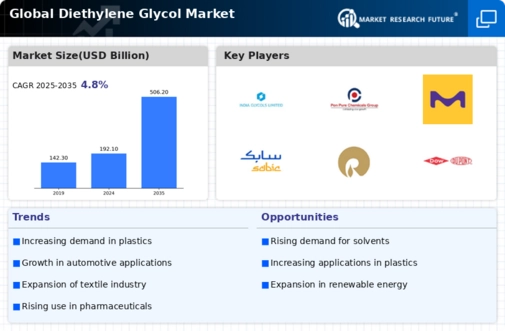Market Analysis
In-depth Analysis of Diethylene Glycol (DEG) Market Industry Landscape
The Diethylene Glycol (DEG) market, a vital component in various industries such as petrochemicals, textiles, and automotive, exhibits a dynamic interplay of factors that significantly influence its trajectory. Understanding these market dynamics is crucial for industry stakeholders and participants to navigate challenges and capitalize on opportunities within this specialized chemical market.
Petrochemical Industry Demand:
The dynamics of the DEG market are closely tied to the demand from the petrochemical industry, where DEG serves as a key intermediate for various chemical processes. Fluctuations in petrochemical demand directly impact the dynamics of the DEG market. Polyester Resin Production:
DEG is a critical component in the production of polyester resins used in textiles, packaging, and automotive applications. The dynamics of the DEG market are influenced by trends in polyester resin demand, which, in turn, depend on consumer preferences and industrial applications. Antifreeze and Coolant Formulations:
DEG is widely utilized in antifreeze and coolant formulations for automotive applications. The dynamics of the DEG market are shaped by factors such as automotive production trends, weather conditions, and advancements in antifreeze technology. Plasticizers in Polymer Industry:
DEG serves as a plasticizer in the polymer industry, contributing to the flexibility and durability of plastic products. Market dynamics are influenced by trends in the polymer industry, including demand for flexible packaging and construction materials. Textile Industry Applications:
The textile industry's demand for DEG in the production of polyester fibers and resins impacts market dynamics. Fluctuations in global textile manufacturing, fashion trends, and innovations in textile materials contribute to the dynamics of the DEG market. Supply Chain and Raw Material Prices:
The DEG market dynamics are sensitive to the availability and pricing of raw materials, such as ethylene oxide. Fluctuations in raw material prices and supply chain disruptions can impact production costs and overall market dynamics. Global Economic Conditions:
The DEG market is influenced by global economic conditions, with demand linked to factors such as GDP growth, industrial production, and consumer spending. Economic downturns can lead to reduced demand for DEG-based products, affecting market dynamics. Regulatory Compliance and Environmental Concerns:
Stringent regulatory standards and environmental considerations impact the dynamics of the DEG market. Compliance with safety and environmental regulations, as well as the development of eco-friendly alternatives, contributes to market evolution. Emerging Applications in Pharmaceutical Industry:
The pharmaceutical industry's growing interest in DEG for certain drug formulations influences market dynamics. Innovations and developments in pharmaceutical applications contribute to the expanding use of DEG in this sector. Competitive Landscape and Industry Consolidation:
The dynamics of the DEG market are shaped by the competitive landscape among manufacturers and suppliers. Mergers, acquisitions, and strategic collaborations impact market share, pricing strategies, and overall competitiveness within the DEG industry.









Leave a Comment